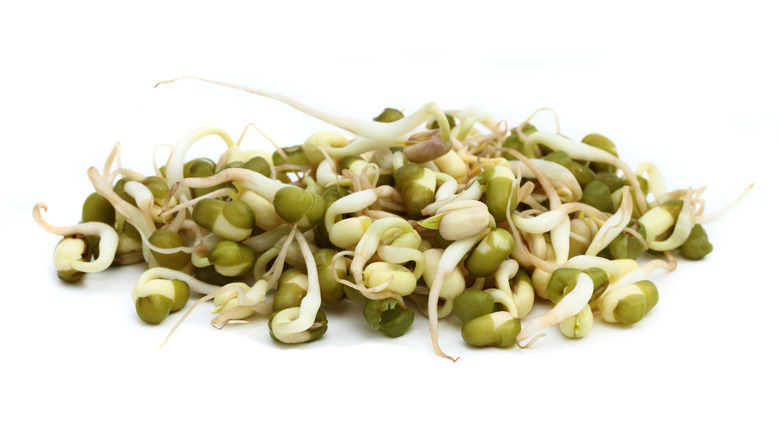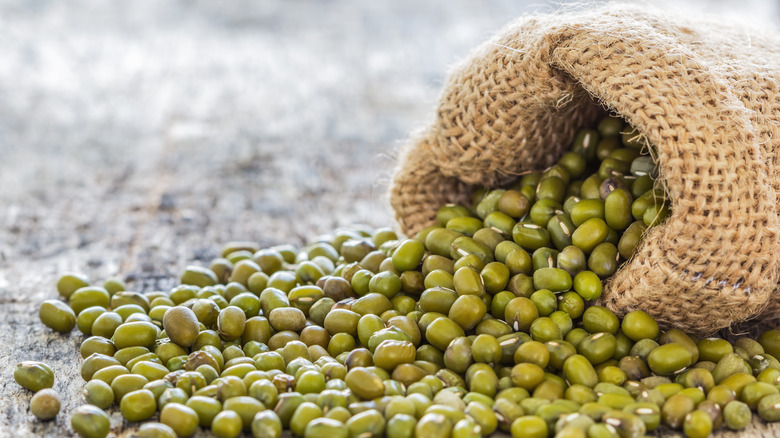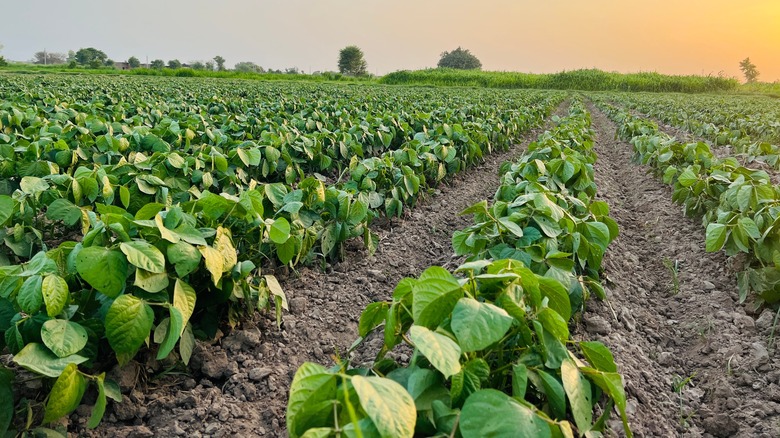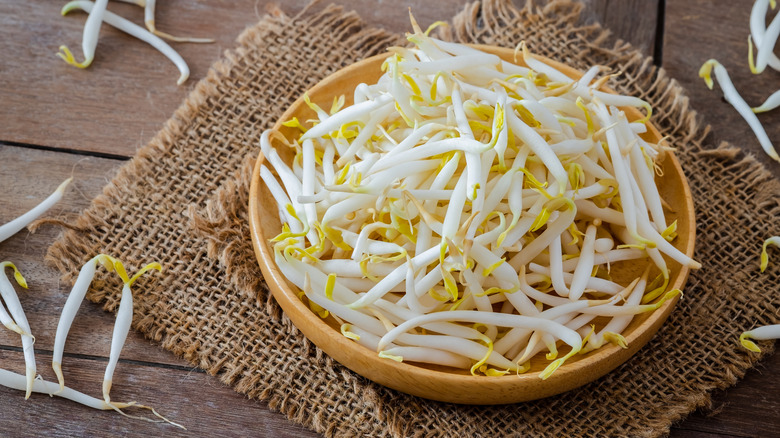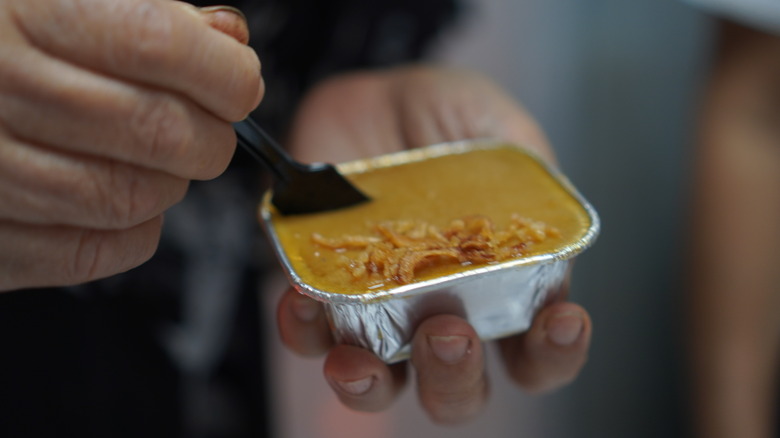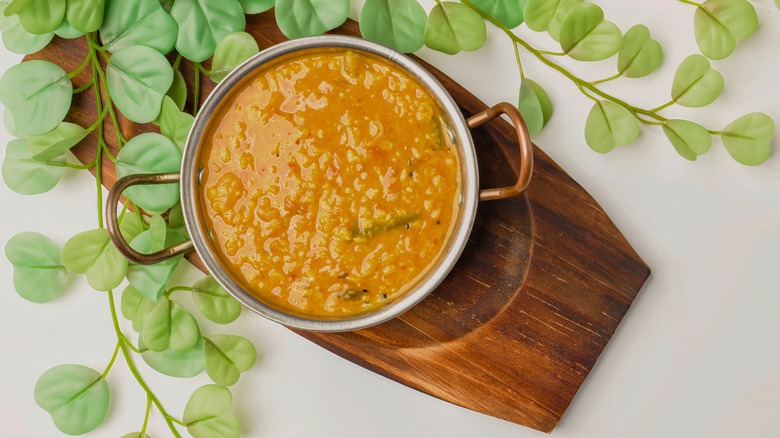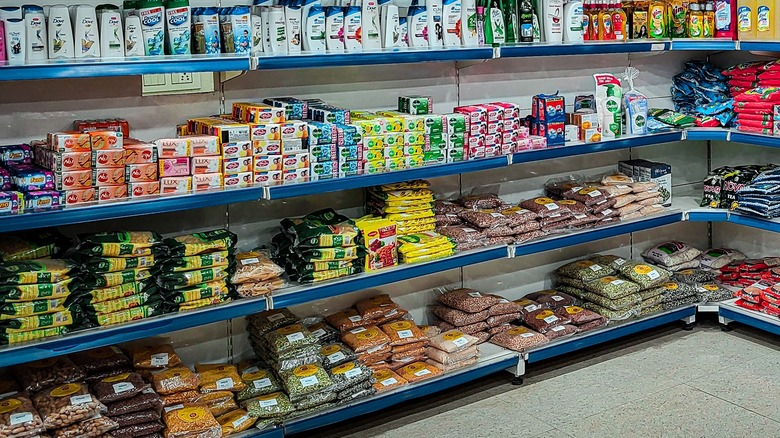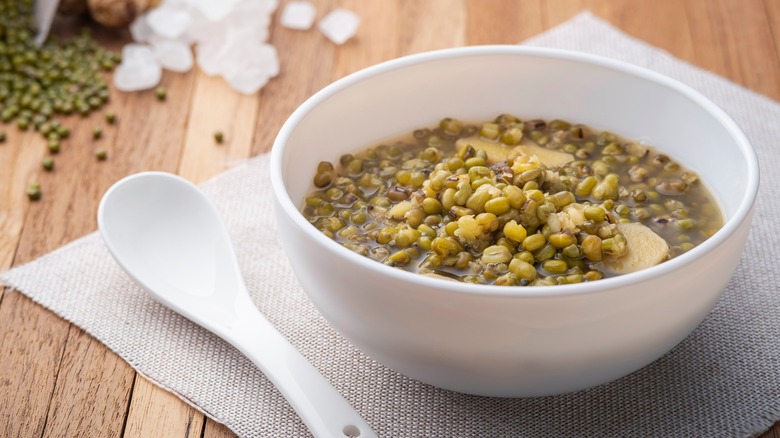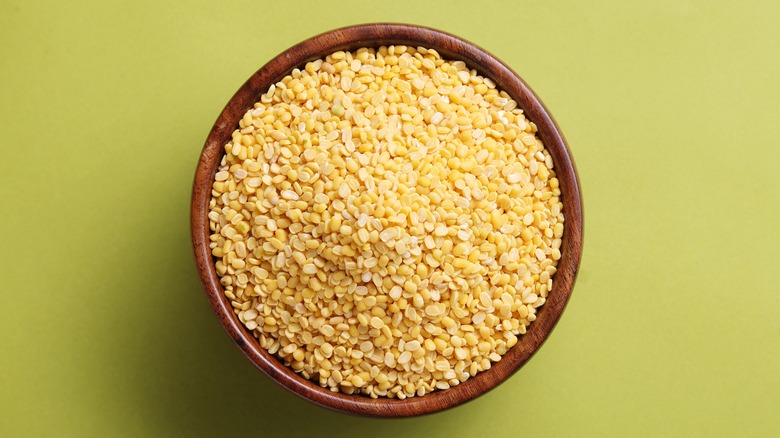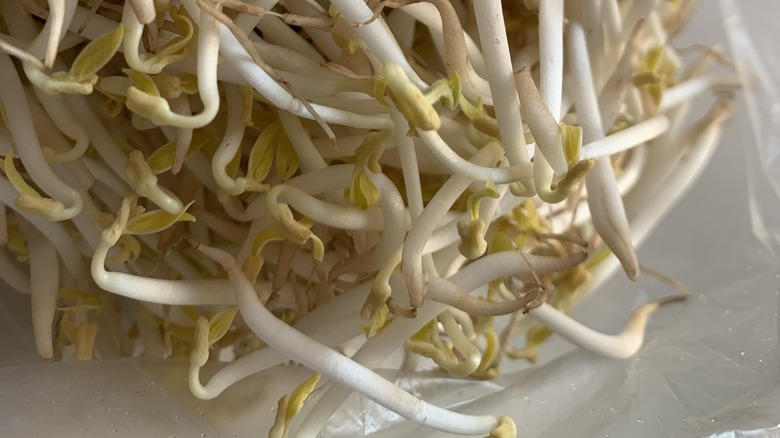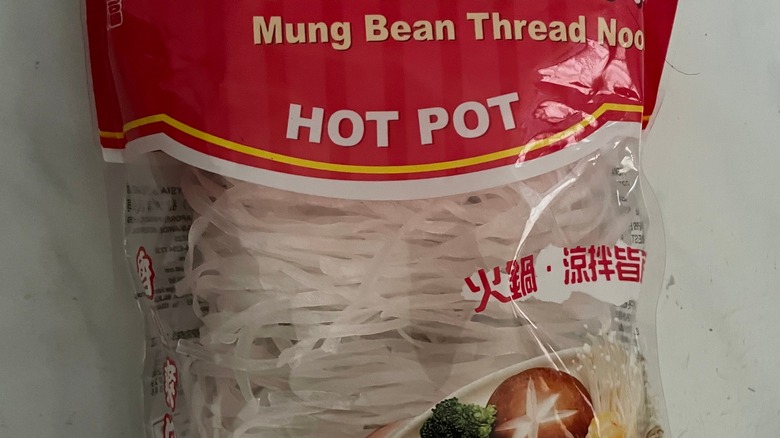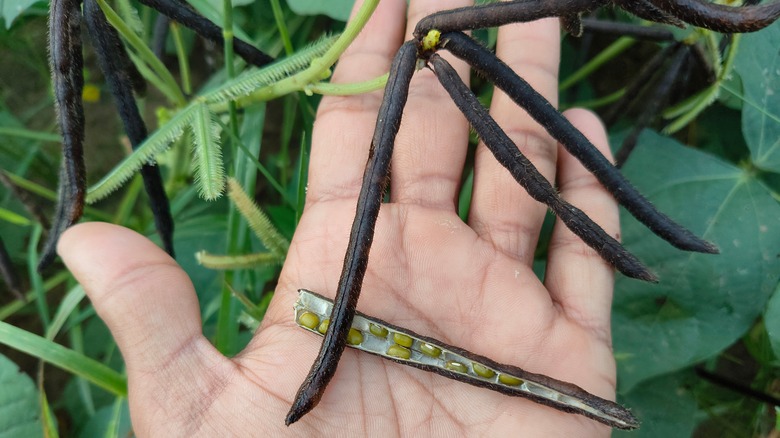What Are Mung Beans And How Do You Cook With Them?
We may receive a commission on purchases made from links.
Mung beans are growing in popularity in the United States, but they've been a major ingredient in several other cuisines for centuries. The tiny beans soften well in cooking, allowing you to turn them into pastes and pancakes, and cooking methods like frying turn the hulled beans into an amazing snack.
Even if you can't picture mung beans in your mind when you hear the name, you've almost certainly had them in one form or another. Do you get crisp, white bean sprouts when you buy a salad? Have you ever had a dish with cellophane noodles? Have you seen bags of a split bean called "moong dal" in local markets? All of those are mung bean products, and there are plenty more. Here's a look at what mung beans are, how to cook with them, and where to find them if you decide to start cooking with them yourself.
What are mung beans?
Mung beans (Vigna radiata) are small, edible beans that are usually sold dry or sprouted. It's thought that the beans first grew either in what's now India or in Iran, and the crops are now grown in several other countries. The beans are highly nutritious and very versatile; as unusual as the name might seem, you've likely had mung beans in the form of their sprouts. That's right — those crunchy white sprouts with yellow tips that live in salad bars and supermarket produce sections across the country are mung bean sprouts.
The beans have both culinary and agricultural uses, and you'll find them in dishes ranging from plain cooked beans to soups to dessert toppings. If you're looking for a new food to try and new recipes to sample, focusing on mung beans could give you ideas for weeks considering how many different cuisines use them.
Where are mung beans grown?
Mung beans are grown in several locations around the world, namely in China, India, Indonesia, Myanmar, and additional countries in Africa and South America. The U.S. grows mung beans, too, mainly in Oklahoma, Texas, and California; however, they aren't a huge crop in this country. That could change, however, if a researcher in Texas has any say about it.
The domestic market for mung beans is growing, and Dr. Waltram Ravelombola of Texas A&M's AgriLife Research and Extension has been looking at which varieties of the plant would grow well in Texas. The idea came from a company called AgriVentis Technologies, which wanted to see if researchers could find a way to adapt mung beans to grow in more areas in Texas. Increasing the domestic supply would help reduce the need for imports, of course, and the beans could be a great crop to alternate with winter wheat. So far, results look promising, although the beans are susceptible to pathogens in humid environments (which pretty much describes most of eastern Texas). Still, Ravelombola has tested the crops in different parts of the state, from northwest to southeast, and found the beans tend to grow well overall.
Sprouted vs. non-sprouted mung beans
The difference between sprouted and non-sprouted mung beans is exactly what it sounds like. Non-sprouted mung beans are just the plain beans or halved beans, with no sprouts growing out of them. Sprouted mung beans have sprouts growing out of them. Sprouted mung beans may have varying lengths of sprouts, but the bean sprouts you use in your salad are obviously well into the sprouting stage.
It doesn't really take that long to produce bean sprouts. Mung beans begin to produce sprouts (when soaked) within a couple of days, and letting the sprouts grow for a couple more — four to five days total — gives you those longer sprouts. The nutritional profile of sprouted and non-sprouted mung beans does change, and both are healthy foods that are good additions to your diet. One advantage to eating sprouted beans instead of non-sprouted beans is that the sprouts can be easier for you to digest.
What do mung beans taste like?
Mung beans taste pretty mild. Some comparisons say the cooked beans are similar to potatoes in flavor, but if you cook them with any spices or other flavored foods, the cooked beans soak up those flavors easily. It's really easy to hide them in food because they don't have a strong taste that overpowers the other ingredients in the recipe, unless the ratios of ingredients are way off, with a lot more beans than other foods and spices
The sprouts are also somewhat mild in flavor, although crisp, fresh bean sprouts do have that bright taste that usually accompanies vegetables that are in good shape. There's an earthiness to the flavor, too, but even that is fairly mild. Bean sprouts are a good ingredient to add to dishes that you want to bulk up without adding too many calories and without changing the flavor of the overall dish.
How to cook with mung beans
Let's start with mung bean sprouts; you can eat them in salads, or you can add them to stir fries, wrap them in spring roll wrappers with sliced veggies, or season them for use as a side dish. You don't want to cook them for too long lest they become soggy and limp; letting them keep some of their crunch is preferable. Do be aware, though, that bean sprouts have been the subject of food recalls before due to the risk of Salmonella poisoning. It's better to blanch the sprouts in boiling water before adding them to salads. If you have immune system issues, are pregnant, or are very old or are cooking for small children, definitely cook the sprouts and always wash them before cooking.
As for the mung beans themselves, you can cook them on the stove top, in a pressure cooker, or in a slow cooker, depending on the recipe. You don't have to soak the halved beans as you would other beans. However, if you're making a dish that requires grinding them to create a paste, soaking them will soften them up and help you achieve better texture. You can also deep-fry yellow halved mung beans to produce a crunchy snack and dessert topping that's common in Thai cuisine. Mung beans are used in Indian curries, too, and you can even sprout the beans yourself at home.
Where can you buy mung beans?
Mung beans are easier to get than you may think, especially if you can order online. It's usually easiest to find them in markets catering to East Asian, Southeast Asian, and South Asian cuisines; Indian markets and Chinese markets should both have them, for example. Sometimes health food and organic markets have them as well, although there are anecdotal reports that it's been a bit harder to find mung beans in some markets since the pandemic. Bean sprouts are usually available in the produce section of most grocery stores.
You can also buy dried mung beans online through sites like Walmart and Amazon. For example, if you want whole green mung beans, Amazon has brands like Yupik Organic Mung Beans. If you want split yellow mung beans, Amazon has Jiva Organic Yellow Moong Dal. If you don't want actual beans but instead want a snack version that you don't need to cook, you can find products like Crunchsters Sprouted Mung Beans.
Mung bean nutrition
Mung beans are relatively low in calories; 1 cup of boiled mung beans has a little over 210 calories and less than a gram of fat. As with other beans, mung beans are terrific sources of fiber, with that 1 cup having over 15 grams of fiber, or about half the amount of fiber you want to get in a day. Mung beans are an awesome source of folate, with about 80% of your recommended daily intake in that 1 cup. You'll also get over 20% and up to 30% of your recommended daily intake of phosphorus, vitamin B1, magnesium, and manganese. In addition to those vitamins and more, mung beans have a few essential amino acids that your body can't produce on its own. Unfortunately, mung beans aren't a complete protein like animal products are, but in combination with the right foods, you could get complete proteins and all of the amino acids you need.
It's vital to note that mung beans contain phytic acid, which can hinder your ability to absorb some minerals. This doesn't permanently make you unable to absorb them; you just might not absorb the full amount you're taking in. Mung bean sprouts have less phytic acid, although the rest of the nutritional profile changes, too, when you eat sprouted beans instead of unsprouted beans.
Varieties of mung beans
In terms of the varieties you could grow in your garden, you've got a few choices that vary according to the climate they grow best in. Some varieties are more heat-tolerant than others, for example. Berken is the main variety sold for growing, but there are a couple of others.
In terms of the mung beans you eat, the available varieties are whole green, green split, and split yellow or orange. The whole, greenish beans are your basic mung bean, and the green split are halved mung beans that still have their skins on them. The split or halved yellow variety are the ones known in Indian cuisine as moong dal and don't have these skins (The green ones are also called "moong" in Indian cuisine, but they don't qualify as moong dal). All three of these choices are available in dried form, and as mentioned previously, you can usually find them in markets selling Indian or South Asian foods, or online.
How to store mung beans
Good storage methods for mung beans depend on whether you're trying to store dry beans or sprouts. Bean sprouts need to be refrigerated; if you bought a bag of them at a store, there should be a best-if-used-by date on the packaging. If you bought them from a bulk bin with no date, the sprouts typically last four or five days. If they go limp, develop mold, or become discolored, toss them. Place the sprouts in a plastic bag that's lined with a paper towel; the towel helps keep the sprouts relatively dry. Don't freeze the sprouts — their texture when thawed won't be very appetizing.
Store dried mung beans like you would other dried beans. Keep them in an airtight container in a cool, dry environment, and use them within a year or so. Light, heat, and excessive humidity will make the beans go bad sooner. Properly stored beans will likely stay good for a while after that first year, but you're best off using them sooner for better quality. You can also store them in the freezer if you're concerned about bugs.
If you have fresh beans that you've harvested from a plant, you'll need to dry them for best storage, and there are ways to dry them at home without special equipment. It's best to check with your local agricultural office, master gardener program, or university agricultural extension office for the procedure that works best in your region.
Do mung beans have any medicinal value?
Mung beans are not only very nutritious, but they have a long history of use in traditional medicinal systems and may contribute to improvements in certain health conditions. Mung beans are excellent sources of protein and fiber — they're a good food for vegetarians and vegans who need to increase their protein intake. Protein helps promote healing, and fiber helps regulate blood sugar. Mung beans are also good sources of several vitamins and minerals, including magnesium, B vitamins, iron, and potassium, among others.
The beans' traditional uses included eliminating toxins and helping clear heat and damp characteristics in Traditional Chinese Medicine. It was thought to be helpful for an upset stomach and reducing heat stroke and inflammation. Studies have shown that compounds within the beans have antifungal properties as well as antimicrobial characteristics. The beans also promote antioxidant activity.
What other uses do mung beans have?
Mung beans are often processed into snacks like chips, which can be a nice option for those who need to eat gluten-free diets, depending on the manufacturer. Mung beans are also used in desserts such as tangshui, a sweet Chinese soup. Korean and Indian cuisines both use mung beans in the batter for pancake-like dishes. Mung bean starch is often used to make bean thread noodles, which are also called cellophane or glass noodles. The noodles look white when uncooked, but as you cook them, they turn translucent. Glass noodles can also be made from other types of starch, such as sweet potato starch — check the ingredient list on a package before buying it to ensure you're getting mung bean starch noodles. Mung bean protein is sometimes used in an egg substitute product.
Mung bean crops have benefits for the soil and future crops, as well as livestock. The plants are often added to animal feed, and mung beans can be used as a cover crop. The plants add nitrogen to the soil, and alternating growing mung beans with another crop like wheat means the wheat can use that additional nitrogen for better growth.
What does a mung bean plant look like?
Mung bean plants grow in a semi-erect or erect form (they're not vines that creep along the ground, for example), up to about 2 1/2 feet for most plants. They have fairly broad leaves when mature and grow clusters of yellow or greenish-yellow flowers at the tips of thin stalks. Each cluster can have between four and 30 flowers — some sources limit the flower numbers to 15 — and the beans develop in long, thin pods that grow out and down from each flower cluster. As you can guess, that means you'll see several pods growing on each stalk that produced a pollinated flower, and one plant can produce up to 40 pods or so. Mung beans are usually self-pollinating.
The seed pods grow darker as they mature, turning almost dark brown to black. The outlines of the seeds show through the pods by the time they're ready to harvest, so each pod looks kind of lumpy. Mature pods can be fragile, and they contain around 10 to 20 seeds each. Fresh seeds can vary in color from green to brown to yellow.
